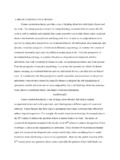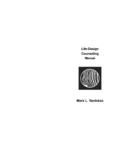Transcription of MCS - Vocopher
1 MCS. MY. CAREER. STORY. An Autobiographical Workbook for Life-Career Success MY CAREER STORY. An Autobiographical Workbook for Life-Career Success Mark L. Savickas and Paul J. Hartung Copyright 2012 by Mark L. Savickas and Paul J. Hartung. A printable PDF. version of this workbook may be downloaded at PURPOSE. People often need help planning and deciding about their career paths. Such help includes figuring out what kind of work they might want to do and how to go about doing it. It also includes planning and feeling in control of their futures, exploring possible careers, and building confidence to do what they want to do and solve problems that might get in the way.
2 Like most people, you may need this help because you are facing a change in your life; like going from high school to college, from school to work, or from one job to the next. And change means making choices. Sometimes taking tests can be helpful to learn about what kinds of jobs and occupations you may like and to make choices. You might have taken a test like this. These tests help with matching you to jobs that seem right for you. Usually, career tests tell about your work-related interests, abilities, and personality. They tell you about what kinds of people you are most like and what kinds of jobs people like you most often do.
3 While often helpful for finding out about what college majors or occupations might fit you best, such tests usually tell just one part of your whole life story. To understand yourself more completely and how you can use work to be the person you want to be, it helps to think about your whole life story. Knowing and telling your own life story, or autobiography, adds meaning to your career plans and choices. That way, you can deepen your life-career planning and decision making by having a clearer sense of direction and purpose. The My Career Story workbook (MCS) aims to help you tell, hear, and author your own life story.
4 Think of the MCS as a mirror that you hold up to look at yourself. By looking closely in this mirror, you can reflect on how you can use school and work in a way that is meaningful to you and that matters to other people. The MCS applies career counseling principles to helping you make choices about current life- career transitions and future career directions. Use it to tell, hear, and put into action your life- career story. The MCS contains a series of questions designed for you to tell about yourself. You then relate your story to a career problem you now face, such as deciding about educational and occupational options and making career plans.
5 By reflecting on your answers to the questions, you will likely be much better able to tell and enact your own career story in terms of who you are, where in the world of work you would like to be, and how you will connect yourself to occupations you may like. 1. USES. The MCS workbook may be used by individuals, groups, and educators for guided self-reflection to increase the meaning and purpose of work in one's life. Individuals: Use the MCS individually to tell, hear, and retell with greater clarity your own life-career story, and identify ways to enact that story in work. Doing so can help you better understand how you want to use work in a way that allows you to become the person you want to be.
6 Groups: Use the MCS in group settings to tell, hear, and retell with greater clarity group members' own life-career stories. Individual group members engage the group as an audience to listen to and help them tell and enact their stories. In turn, they provide an audience for other group members as they listen to and reflect on other members' stories. Educators: Use the MCS as the syllabus or an activity for a high school or college career orientation/education course to increase students' ability to tell, hear, and retell with greater clarity and comprehension their emerging life-career stories and enact those stories in school and work.
7 GENERAL DIRECTIONS. The MCS contains three parts. In Part I, Telling My Story, you will answer several questions about yourself. Your answer to each question tells one part of your whole life-career story. In Part II, Hearing My Story, you will use your answers from Part I to tell your career story with greater clarity and comprehension. In so doing, you will better understand yourself, your interests, and your passion in life. Together, the story you tell in Part I and the portrait you construct in Part II will help you realize who you are as the lead character in your own life-career story, where in the world of work you would most like to be who you are, and how you believe you can connect yourself to possible work settings.
8 In Part III, Enacting My Story, you will make a realistic plan to put your story into action. 2. PART I. TELLING MY STORY. A. You are probably using this workbook because you are facing some change or transition in your life; maybe from high school to college, from school to work, or from job to job. To bridge transitions, or end one chapter and begin the next, and clarify choices, people look within themselves to their own life story for guidance. In the lines below, write a brief essay telling about the transition you now face and how you hope this workbook will be useful. 3. B. Now, list all of the occupations you have thought about doing.
9 List the occupations or jobs you are thinking about doing now and those occupations or jobs you have ever thought about doing in the past. You might have several, just one or two, or none at all. 4. C. Write your answers to the following four questions in the spaces provided. 1. Who did you admire when you were growing up? Who were your heroes or heroines? List three people, other than your mom and dad, who you admired when you were a child of about six, seven, or eight years old. These can be real people you know or don't know personally, make-believe people like superheroes and cartoon characters, or anybody else you can think of.
10 Maybe you admired a neighbor or a teacher, an athlete, a politician, a scientist, an artist or musician, a star, or a character in a book. List your three heroes or heroines on the lines on the next page. Then, for each character, describe in 2-4 sentences in the space provided what you admired about them. For example, if you admired Anne of Green Gables you might write that she is independent and spunky. Or, if you admired Dr. Martin Luther King, Jr. you might write that he was a leader who fought for social justice. If you admired Superman you might write that he fought for truth and justice. 5. My three heroes or heroines and what I admire about them are: a.




